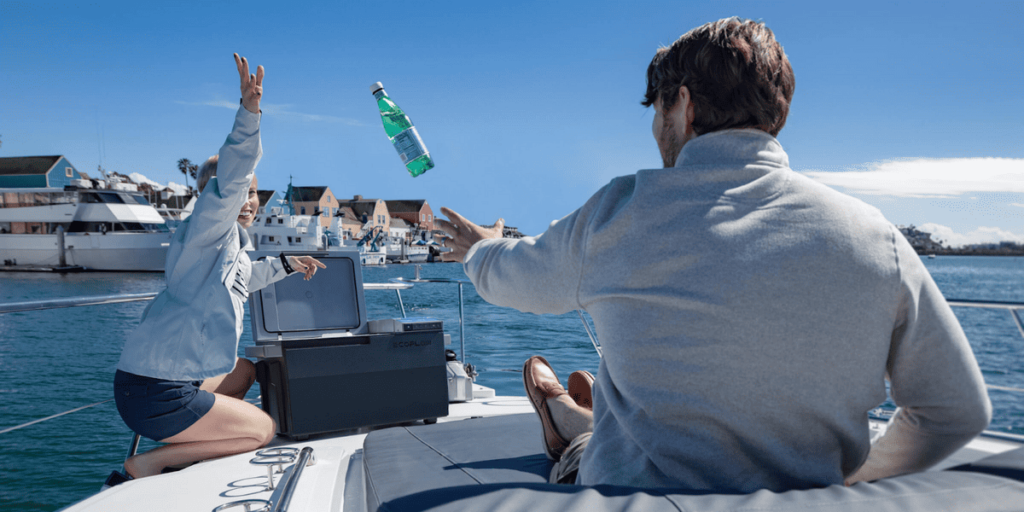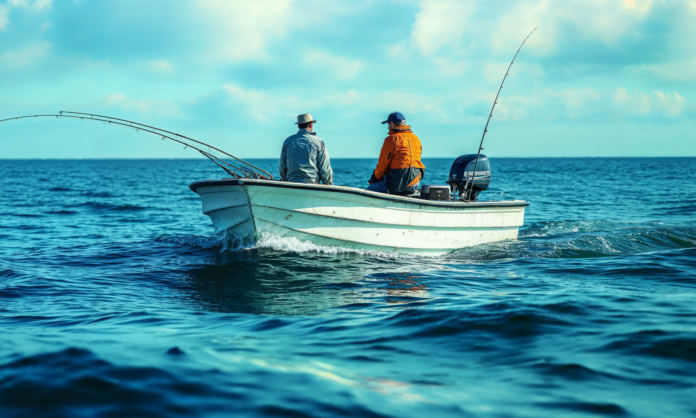Table of Contents
Embarking on a bass fishing adventure promises a thrilling and rewarding experience. Whether passing time with loved ones on the lake or delving into an angling competition, bass fishing is a riveting pastime. Newcomers and experienced anglers should grasp these fundamentals and techniques to elevate their fishing game and catch rate.
Dive into bass fishing basics by learning the best gear for your trip and the optimal fishing time. Conduct thorough research on the species, and you’ll soon be hauling in monster bass.
Bass Fishing Basics
Bass Species
Largemouth Bass
The most iconic freshwater game fish is the largemouth bass, which has an olive-green hue, white underbelly, and a dark horizontal stripe on each side. Residing in shallower sections of North America’s freshwater lakes, ponds, and reservoirs, they love cover, so look for vegetation, sunk trees, or other submerged objects where they might be hiding.
Smallmouth Bass
You can find smallmouth bass in large, clear-water lakes and clear, cool streams. They have a brownish-green hue with several dark vertical bands on their sides. Compared to largemouth bass, they have smaller bodies. Native to North America, these are fun for angulars due to their aggressive nature and impressive leaps when hooked.
Striped Bass
Also known as striper, the striped bass is silvery with green shading on top, a white belly, and seven to eight dark horizontal stripes on each side of its body. The striped bass prefers freshwater and saltwater, living in bays, estuaries, and coastal water across the Atlantic coast of North America.
Bass Behavior
While there are many species of bass, they all exhibit similar behaviors. Understanding these behaviors will increase your chances of having a fun, successful angling expedition.
- Sunlight: Bass are more active during overcast or low sunlight days. Their preference for lighter conditions is also why they tend to feed nocturnally.
- Feeding Habits: In warmer months, they become more active at night and in the early morning, so factor this into your trip planning.
- Depth Changes: Bass move to deeper depths in colder months to escape the harsh temperatures before returning to shallower water in summer. They also seek cover and will change depth based on available cover.
- Sensitivity to Vibrations: Bass fish are responsive to water vibrations, making them more likely to engage in enticing lure movements.
- Territorial Pattern: During spawning season, males will defend specific areas. They will strike intruders to keep them from approaching the nest.
Bass Fishing Regulations
Catch & Size Limits
Catch and size limits maintain sustainable bass populations and keep fisheries healthy. Fisheries management authorities set these limits to balance recreational angling and conservation. Catch limits define how many fish an angular can harvest in a set time, typically a season or a given day, preventing overexploitation. Size limits mandate the release of bass below a specific length, protecting younger fish.
Licensing
Fishing licensing also plays a role in bass conservation, with government agencies administering specific fishing licenses. In the United States, the requirements for licensing vary by state. You’ll need to register in the state you plan to fish in since each has different regulations. Becoming licensed to fish is a legal obligation and necessary for responsible and ethical fishing.

What Gear Do I Need To Catch Bass?
Rod
The right rod and reel depends on your fishing technique and the type of lures you plan to use. Choose a rod with medium to heavy power and moderately fast action, which is best for catching more prominent bass. Graphite and graphite composite materials are loved for bass fishing because they are lightweight and sensitive.
Reel
Like a rod, a good reel depends on your fishing type. Baitcasting reels are great for using larger lures but can be difficult for beginners. Smaller lures require spinning reels. The gear ratio depends on your retrial speed; higher ratios are suitable for faster techniques and smaller for slower ones. Reels with more ball bearings are also smoother to operate.
Fishing Line
Choose a fishing line based on the material: monofilament, fluorocarbon, or braided. The strength of the fishing line is essential for the size of the fish caught.
Lures
Different situations require different lures, such as water clarity and bass behavior. Having the right lure entices the fish for strikes and enables a successful catch. Some popular lure types are jigs, crankbaits, and topwater lures.
Portable Power Solution
If you plan to spend an extended period on the lake, you’ll want to ensure you keep your devices charged, including phones, fridges, and your boat’s power. Ecoflow Solar Generators are perfect for powering boat batteries, GPS, and even sonar fish finders. Combine a generator with panels such as EcoFlow Solar Panels and an EcoFlow Portable Power Station for high-tier off-grid electricity generation and storage throughout your fishing trip.

When Is the Best Time To Fish For Bass?
The best time to catch bass depends on seasonal and daily patterns. To maximize your chances of a successful fishing trip, you need to understand their spawning behavior and their preferences for light and temperature.
The best season to find bass is late spring and fall. They are most active in these seasons when the water temperatures are milder. During the winter, the water is too cold, and the fish move to deeper water. The water can reach high temperatures in the summer, forcing them to lower depths again.
After selecting a fishing season, understanding the optimal time of day enhances success. Early morning and late afternoons with low light conditions have increased activity in bait fish like minnows and shiners. This activity draws out bass for feeding, making this a great time to catch them.
The number of bass feeding is vastly higher at night time compared to other times of the day. Moreover, there is less traffic on the water at night than in the day, so the fish are less disturbed. In the summer, the water cools to a preferable temperature for them to feed.
If you plan to be on the water for a more extended trip at night, the EcoFlow RIVER 2 Pro + 220W Solar Panel is an ideal tool to keep yourself powered throughout. This portable power station can cook your catch with an electric frying pan or power a fish finder for several hours.
Choosing the best solar generator for your fishing excursion depends on what you need to be powered and for how long. The EcoFlow RIVER 2 Max + 160W Solar Panel is the best lightweight solar generator for shorter fishing trips at dawn or dusk, and it’s essential to keep your devices powered in case of emergency.

10 Bass Fishing Tips for Beginners
Start With Basic Gear
You don’t need top-of-the-line gear to start fishing; begin with gear that fits your budget and trade up to better rods and reels later. You can use a few simple lures to catch bass, but evaluate your gadgets and get the right solar generator for a successful excursion. Portable fridges such as EcoFlow Glacier Portable Fridges can store your bait and catch and keep your drinks cold throughout.
Identify Cover
While waiting to attack prey, bass conceal themselves under cover. If you want to increase your chance of catching them, you need to be able to find cover to put your lure in. Examples of cover are wood, grass, sunk items, rocks, and boat docks.
Begin Fishing in Shallow Water
As a beginner, you’ll likely find ample cover in shallow waters. Bass move to shallow water during spawn season, so directly after this is the perfect time to get out in these areas. In warmer months, they actively feed in shallow areas during low-light times.
Fish With the Right Lures
Bass have a versatile diet, but only certain prey are available in specific regions. For the highest chance of success, you’ll want your lures to mimic the prey of the local area closely. Watch lure color and size to match their natural prey.
Practice Casting
Casting is a fundamental skill for any angular. When beginning to fish for bass, choose an open area to practice and avoid snagging your line. Focus on your technique, learn overhead versus sidearm casts, work on distance, and practice accuracy. Perfecting casting takes time, but with practice, you’ll see improvements.
Learn Different Knots
Knowing how to tie different knots can save you time and frustration on the water. The Clinch, Palomar, Uni, and Snell are excellent beginner knots to practice. Use knots to tie hooks, lures, or swivels directly to the fishing line. You don’t want to lose a great catch because of a bad knot.
Be Adaptable
It’s easy to resist change once you’ve started a routine. But you’ll only grow as an angular if you become more versatile. Exploring new fishing locations, mastering new techniques, and joining a fishing community are easy ways to get out of your comfort zone.
Keep a Fishing Journal
Keeping a fishing journal is a fantastic way to observe and track fishing patterns. Include critical information about the day, such as time, weather, and location. Record the type of fish caught, which lures and baits are used, your techniques, and the depths and structures present. Review this data over time to improve your skills and opportunities.
Educate Yourself
Becoming a better angular is a continuous learning process. Research bass behavior, fishing techniques, catch and release conservation, and local regulations when starting. Before hitting the water, look at maps of the area and identify areas like ledges and creeks to head to.
Be Patient
Patience is always a virtue– especially in bass fishing. When frustrated, practice patience by slowing your retrieval speed, trying different lures, observing signs of activity in the water, and continuing to research behaviors and fishing techniques.
Frequently Asked Question
There are many reasons why you may not be catching bass. Ensure you are in the best location at the right time, and look for shallow areas with cover during low-light times. Consider other factors like lures and retrieval speeds. Experiment with different techniques with patience and persistence for the best success.
The best bait will depend on water conditions, seasons, and local areas. Do your research on the location and season, then experiment with different bait to find what works. Some popular choices are crankbaits, jigs, spinnerbaits, and plastic worms. Depending on regulations, consider using live bait like shiners and nightcrawlers.
Focus on bass habits—fish near covers and in shallow water where they like to hide. Bass are most active during low light conditions like dawn, dusk, and night. For beginners, practice casting techniques, knot tying, and retrieval speeds. If your approach is not yielding results, be patient and try another method.
Final Thoughts
Successful bass fishing begins with understanding different bass species like largemouth, smallmouth, and striped bass. Study their behavior patterns to make informed decisions for your fishing expedition. Bass love low-light conditions and warm water. So, the best time to plan a trip is at dawn, dusk, or nighttime in late spring or fall.
Then, consider what gear you need to catch bass—a rod, reel, and fishing line. If you invest in gadgets like fish sonars, you’ll also need a reliable energy source to level up your fishing game and keep devices charged on the water. If you’re new to the hobby, simple gear, practicing technique, and staying patient are great places to start. Check out EcoFlow’s Portable Power Station and EcoFlow’s Solar Generators for dependable energy to keep everything charged and running while enjoying the perfect fishing trip.
